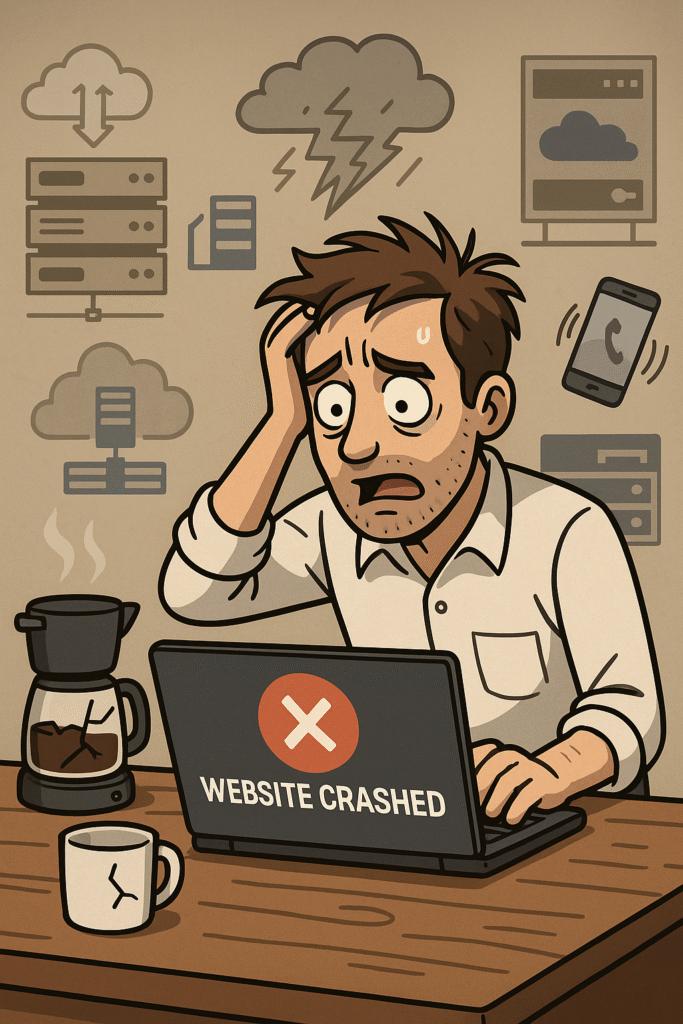Hosting Ruined My Tuesday (Or Was It Wednesday?)
So there I was, trying to figure out hosting. But nothing made sense at first. Then my website crashed at 3 AM on a Tuesday. Because apparently, shared hosting wasn’t cutting it anymore.
First, let me explain something. Hosting seemed simple when I started. But actually? Total disaster waiting to happen. Plus my coffee maker broke that same morning, so everything felt cursed.
Meanwhile, my clients kept calling. Also, their websites were loading slower than molasses. That’s when I discovered VPS hosting. Because honestly? Game changer.
But First, Let Me Explain What VPS Actually Means
VPS stands for Virtual Private Server. Basically, it’s like having your own apartment instead of sharing a dorm room. So you get more control over your space. Plus other people’s mess doesn’t affect your stuff.
Then again, shared hosting is like living in a crowded dorm. When someone’s having a loud party, everyone suffers. But with VPS hosting, you get your own little corner of the server. Because that’s just how it works.
Actually, think of it this way. Shared hosting is like taking the bus. Sometimes it’s crowded. Other times people are weird. Plus you can’t control the temperature. But VPS hosting is like having your own car. So you decide when to leave, where to go, and what music to play.
So Then Hosting Problems Started Getting Real
Last month, my shared hosting died during Black Friday. Because apparently, everyone decided to shop at the same time. First, my site slowed down. Then it completely crashed. After that, I lost three potential customers.
But here’s the thing. Shared hosting providers cram hundreds of websites onto one server. So when one site gets busy, everyone else suffers. Plus they don’t tell you this upfront. Meanwhile, your business is bleeding money.
That’s why VPS hosting makes sense. Because you get guaranteed resources. So if your neighbor’s website goes viral, it doesn’t crash your stuff. Also, you can actually fix problems when they happen.
Meanwhile, VPS Hosting Was Being Weird (In a Good Way)
Actually, VPS hosting isn’t that complicated. But people make it sound scary. So let me break it down simply.
First, you get root access. Basically, you’re the boss of your server. Then you can install whatever software you want. Plus you control security settings. Because nobody else can mess with your setup.
But here’s what really matters. Performance stays consistent. So your website loads fast even when traffic spikes. Also, you can upgrade resources without moving to a new server. Meanwhile, shared hosting users are stuck waiting for their provider to fix stuff.
Because Hosting Is Like That (Choosing the Right VPS)
So anyway, not all VPS providers are the same. Some are awesome. Others will make you want to throw your laptop out the window. Plus prices vary wildly for similar services.
Then I spent weeks researching options. Because honestly, I didn’t want another hosting disaster. First, I made a list of requirements. Second, I tested different providers. After that, patterns started emerging.
Here’s what actually matters when choosing VPS hosting:
Server Location Stuff Choose servers close to your audience. Because distance affects loading speed. So if your customers are in New York, pick a data center on the East Coast. Plus some providers offer multiple locations.
Resource Flexibility Things Look for scalable options. Because your needs will change over time. First, you might need basic resources. Then your traffic grows. But good VPS providers let you upgrade easily. Also, some offer automatic scaling.
Support Quality Issues Test their support before buying. Because 3 AM server crashes happen. So send them a question during their “24/7” support hours. Then see how fast they respond. Plus check if they actually solve problems or just send template responses.
Also, VPS Costs Money Now (But It’s Worth It)
Actually, VPS hosting isn’t that expensive anymore. But pricing can be confusing. So let me explain how costs work.
First, basic VPS plans start around $5-10 monthly. Then prices go up based on resources. But here’s the thing. Cheap shared hosting might cost $3 monthly. Plus it comes with headaches. Meanwhile, VPS hosting gives you peace of mind.
Also, calculate the real cost. Because downtime costs money. So if your shared hosting crashes during peak hours, you lose sales. But VPS hosting prevents most of these problems. Plus you sleep better at night.
But Actually, Here’s Where to Get VPS Hosting
After testing dozens of providers, some clearly stood out. Because not all hosting companies are created equal. So here are the best options:
DigitalOcean for Beginners Super simple setup process. Plus their documentation is actually helpful. Because most hosting docs are written by robots. But DigitalOcean explains things clearly. Also, they offer $100 credit for new users. Meanwhile, their pricing stays predictable.
Linode for Power Users Been around forever. Because they know what developers need. First, their servers are fast. Second, support actually understands technical stuff. Plus they offer specialized configurations. But setup might intimidate beginners.
Vultr for Global Reach Tons of server locations worldwide. So you can pick the perfect spot for your audience. Plus their interface is user-friendly. Because some providers make simple tasks complicated. Also, they offer hourly billing. Meanwhile, you only pay for what you use.
Amazon AWS for Enterprise Industry standard for big companies. But honestly? Overkill for most small businesses. Because their pricing is confusing. Plus you need a degree in cloud computing to understand their options. Then again, it’s incredibly powerful once you figure it out.
First of All, Hosting Setup Is Weird
Setting up VPS hosting scared me initially. Because it seemed too technical. But actually, most providers offer one-click installations now. So you can get WordPress running in minutes. Plus they provide tutorials for everything.
Then I realized something important. Because VPS hosting gives you control, you can fix problems yourself. Meanwhile, shared hosting forces you to wait for support tickets. But with VPS, you’re the boss. Also, you learn valuable skills along the way.
Here’s my basic setup process:
Choose your operating system. Because Linux is usually cheaper than Windows. Plus most web applications run fine on Linux. Then pick your control panel. But honestly, many people skip this step. Because command line isn’t that scary once you try it.
So Basically, Don’t Do What I Did (Common Mistakes)
Actually, I made tons of mistakes when starting. Because nobody warns you about the gotchas. So let me save you some headaches.
First mistake was choosing the cheapest option. But cheap VPS hosting often means oversold servers. Plus support quality suffers. Meanwhile, spending $5-10 more monthly gets you much better service. Because you get what you pay for.
Second mistake was ignoring backups. Actually, I thought the hosting provider handled this automatically. But many VPS plans don’t include backups. So set this up immediately. Plus test your restore process before you need it.
Third mistake was picking the wrong server location. Because I chose based on the provider’s main website location. But server location affects your site speed. So pick based on where your visitors live. Also, some countries have data privacy laws affecting server choice.
Then Again, Maybe That’s Just Me (Advanced Stuff)
After using VPS hosting for months, some advanced features became useful. Because initially, basic hosting seemed sufficient. But then my needs grew.
Load balancers help when traffic spikes. So instead of one server handling everything, you can spread the load. Plus this prevents crashes during busy periods. But honestly, most small sites don’t need this yet. Because it adds complexity.
CDN integration makes sites faster globally. So your content gets cached worldwide. Then visitors get served from nearby locations. Plus it reduces server load. Meanwhile, many CDN services offer free tiers. Because they want you to upgrade later.
Database optimization becomes important eventually. But most people ignore this until problems appear. So monitor your database performance. Plus regular maintenance prevents slowdowns. Because databases get messy over time.
Another Thing About Hosting Performance
Actually, VPS performance depends on more than just specs. Because the underlying hardware matters too. So two providers with identical RAM and CPU might perform differently. Plus network quality affects everything.
That’s why I test performance before committing. Because marketing promises don’t always match reality. So run speed tests from different locations. Then check uptime statistics. Plus read recent reviews from actual users. Meanwhile, avoid providers with lots of complaints.
Oh And Security Stuff Matters Too
Security scared me initially with VPS hosting. Because suddenly I was responsible for everything. But actually, it’s not that complicated. So here’s what you need to know.
First, change default passwords immediately. Because hackers try common passwords first. Then set up a firewall. Plus keep your software updated. But honestly, these are basic steps. Meanwhile, shared hosting handles this stuff automatically.
Also, consider managed VPS options. Because they handle security updates for you. Plus you get expert support when problems happen. But managed plans cost more. Then again, your time has value too.
Because Hosting Migration Is Scary
Moving from shared hosting to VPS seemed terrifying. But actually, most providers help with this process. So you don’t have to figure it out alone. Plus many offer free migration services. Because they want your business.
Then I discovered something cool. Because VPS hosting lets you test everything before switching. So set up your new server first. Then copy your site over. Plus run tests to make sure everything works. After that, update your domain settings. Meanwhile, your visitors won’t notice the change.
Anyway, Here’s My Final Hosting Advice
So hosting isn’t rocket science. But it’s not exactly simple either. Plus everyone’s needs are different. That’s why research matters before choosing.
But here’s what I’d tell my past self. Because hindsight is 20/20. First, don’t wait until your current hosting fails. Second, budget for quality service. Then test thoroughly before committing. Plus have backup plans ready.
VPS hosting changed how I think about websites. Because suddenly, I had control over performance. So instead of hoping shared hosting would work, I could make it work. Plus scaling became possible without starting over.
Actually, the biggest lesson was this. Because good hosting is invisible. So when everything works smoothly, you forget about it. But when hosting fails, it affects everything else. Meanwhile, your business keeps running regardless of technical problems.
So Yeah, Hosting Matters More Than You Think
After months of using VPS hosting, I can’t imagine going back. Because the control and reliability are worth the extra cost. Plus learning server management opened new opportunities. So what started as a necessity became a valuable skill.
But honestly, hosting is just a tool. Because the real goal is serving your audience effectively. So choose whatever helps you do that better. Plus don’t overthink the technical details initially. Meanwhile, you can always upgrade your knowledge over time.
Actually, that’s the beauty of VPS hosting. Because it grows with your needs. So start simple. Then add complexity gradually. Plus most providers offer tons of documentation and support. That’s why VPS hosting works for beginners and experts alike.


